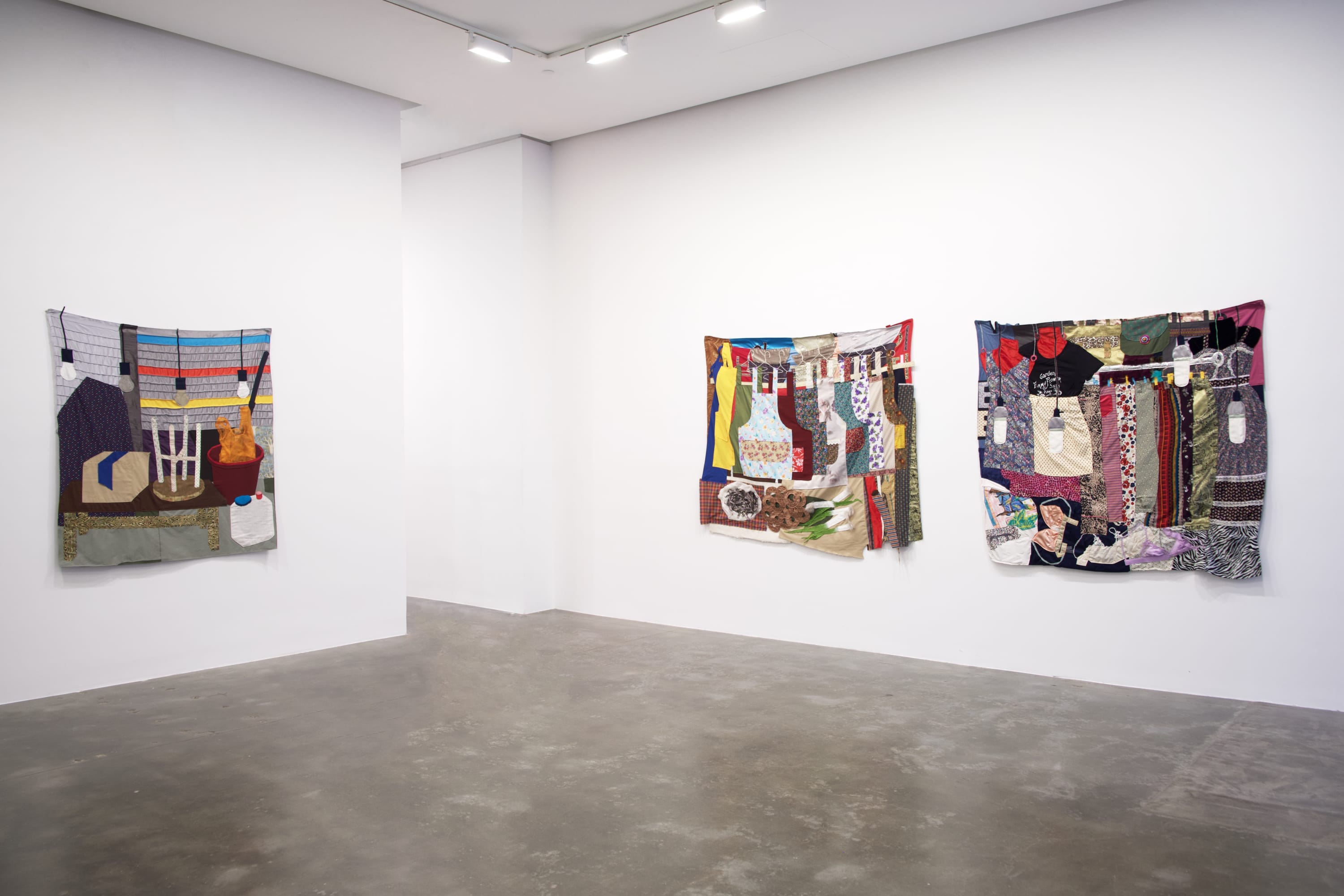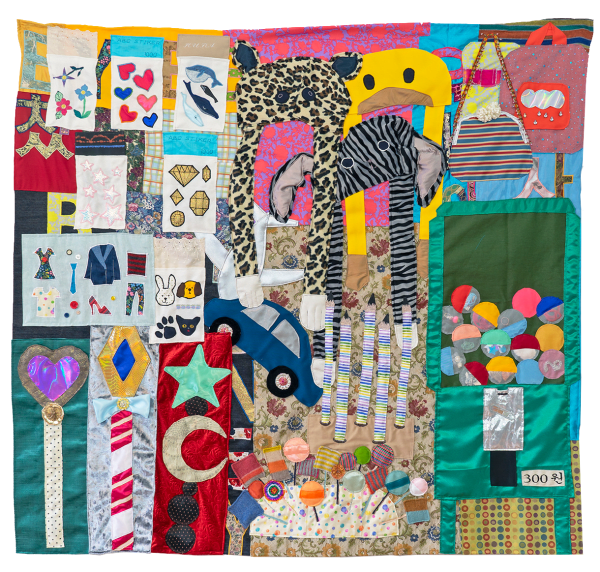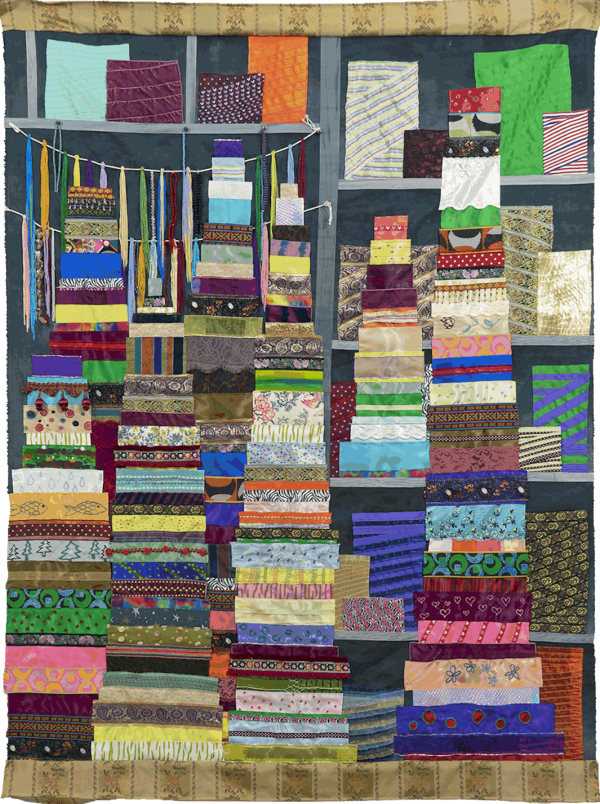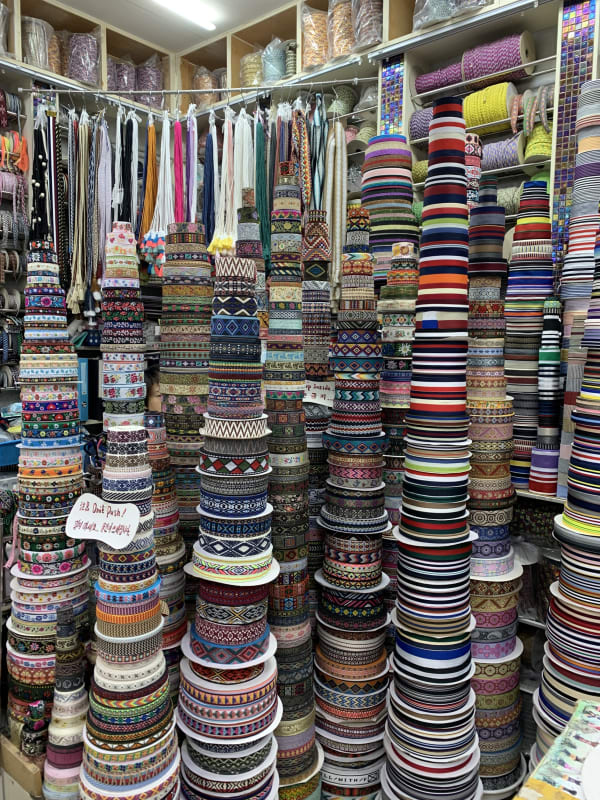-
Woomin Kim: Shijang Project
-
Susan Inglett Gallery is pleased to announce Woomin Kim's solo exhibition, Shijang Project, on view from 9 June 2022 through 29 July 2022.
-
Installation View, Woomin Kim Shijang Project at Susan Inglett Gallery, NYC.
-

WOOMIN KIM, Shijang: Clothing Store , 2021
-
Noor Tamari: Can you give me a general understanding of this series and expand on some of the scenarios and stories depicted in the work—what do these places mean to you personally?
Woomin Kim: Shijang Project is a series of quilts that describe the landscape of street markets common in Korea. Each quilt depicts a store in a Shijang such as a ribbon store, a fish market, a hardware store, a general store, a shoe store, etc. The works seen hanging together mimick the structure of Shijangs, and the installation as a whole is intended to subvert romantic and xenophobic Western narratives of the street markets of Asia. At the same time, the works suggest a more personal and accurate narrative of these markets as places that are vibrant, energetic, and lively. The title of each quilt corresponds to the stores they depict. Stores that are unique in Korean culture and awkward to translate into English, such as Shijang: Munbangu or Shijang:Yakjae-sang, are titled in Korean.
A Munbangu is a store where school children go to buy toys or candies. They also sell materials for school homework such as notebooks, science lab kits or art materials. Children would also get their assignments laminated or printed there as well. Munbangus are disappearing since the school system is changing and internet shopping is more popular now, but these stores still hold a special significance for children and are a precious memory for many adults in Korea.
-
Yakjae-sang are stores that sell ingredients for herbal medicines such as different kinds of tree barks, roots, mushrooms, dried berries and leaves, etc. Doctors who specialize in traditional eastern medicine combine these ingredients into more complicated treatments, and common people use these ingredients to make tea or spice—something less intense
-
As cities push for development, Shijangs in various neighborhoods are under threat of eviction or of being remodeled into something “modern.” As you can imagine, development plans often interrupt the ecosystem of the Shijang community and a lot of the stores and vendors end up leaving or fail to adapt to the changing urban environment. The work, Shijang: Out of Business depicts one of the stores that was closed permanently as a result of these changes.
-

WOOMIN KIM, Shijang: Out of Business, 2021
Woomin Kim, Shijang: Out of Business, 2021
-
Tamari: How did this project begin? In what ways is Shijang Project connected to the banner competition at the Noguchi museum?
Kim: I started developing Shijang Project at the end of 2020, at the height of the horror and confusion brought on by the pandemic and about a year prior to the Noguchi program. During this period I was working in my studio apartment in Jackson Heights, where I was living with my partner. It was a limited working environment in terms of space and setting but it was also a perfect opportunity for me to start a new project that involved quilting/textile collage, something that I had been hoping to develop for some time. Since the onset of the pandemic, hate and violence towards Asian owned businesses, communities, and neighborhoods had risen, although this wasn’t anything new. The misguided and xenophobic narrative towards Asian markets had especially gotten out of control during this time. Growing up in Korea, Shijangs were a place to hang out, eat, shop, connect and celebrate. In contrast, the Western narrative of Asian markets, as often seen in Hollywood movies as dark, dangerous, and mysterious, seemed completely inaccurate and violent.
-

WOOMIN KIM, Shijang: Aisle, 2021
-
Using fabric, a material that is deeply related to everyone’s daily lives, bodies and personal memories, I decided to create depictions of Shijangs that reflected my understanding of these markets as vibrant and energetic places.
-
-
Tamari: What drew you to using fabric and textiles in your work in general?
Kim: I can’t remember the moment I decided to adopt textile in my work. Ever since I was a little kid I played with fabric, making clothing for my dolls. Almost every project I did in or after school somehow involved fabric. As far back as I can remember, I always loved fabric, whether clothing or wall hangings. I like how fabric is flexible, soft and has the infinite possibility of becoming something different, whether flat or structural, while also being extremely versatile and diverse in terms of its materiality, colors, patterns, movement and culture. If you follow the process of how cotton, cocoons (silk), petroleum, wool, etc. become fabric, it’s like watching a birth.
Since a lot of what I describe or reference in my work is daily life and a typical urban landscape, I find it important to work with material that has a democratic quality. Fabric can be glamorous but also very comfortable and familiar. We touch fabric all of the time, wrap ourselves in it, eat on it, sleep under it, hang it over our windows or lay it on the floor. Everyone grew up with their own memories and connections to fabric.
-
Tamari: How do you source materials for these works?
Kim: When I started the project, I didn’t need to collect much fabric. I was primarily using fabrics that I already had from old clothing and bed sheets. Also, whenever I’d visit my family in Korea I’d go shopping at some of my favorite places in Seoul, the fabric districts in the Dongdaemun Shijang and the Gwangjang Shijang. When I’d return home I’d bring various fabrics back to my studio. As the project developed and when I needed more fabric, I visited local fabric stores in Queens near where I live. -
Tamari: What and who are your inspirations? What references are you drawing from? I’m wondering if your work is inspired by Jogakbo, Chaekgeori, and/or traditional American quilting, and in what ways?
Kim: I have often adopted the aesthetic of Jogakbo. Jogakbo are the traditional Korean quilts that were popular among common people during the Joseon Dynasty. As the name describes (Jogak means "pieces" and Bo means "large fabric"), Jogakbos are made of dozens, sometimes hundreds, of small scraps of fabric that were leftover and saved after making clothing or other larger items. Since the pieces were sewn together by hand, the abstract geometric patterns have an organic and human quality to it. Wealthier households would create these Jogakbos with silk or high-quality linen, and common people would create them using cheaper everyday materials such as cotton or rough rami. These quilts are used to cover prepared meals before they are served, as well as for wall-hangings, seat cushions, and blankets.
The straightforward perspective and description of objects from Chaekgeori, Chaekgado, and Chochungdo were inspirations as well. (Editor's Note: Chaekgeori translates as "books and things," it is a genre of Korean still-life painting from the Joseon period that features books as the dominant subject. Similarly Chochungdo features plants and animals.)
-
The textiles that inspired Shijang Project most were the banners and textiles found hanging in actual Shijangs. The aisles and passages of the Shijangs are often decorated with all kinds of banners with designs that reference holiday celebrations, advertisements, national flags, images of the twelve zodiac animals, etc. In addition, Shijangs are naturally full of simple yellow or green tarps and vinyls used for roofing, and as shades and dividers, amplifying the vibrant and celebratory vibe of these places.
-
-
Tamari: What do you hope visitors will take away from the exhibition?
Kim: I hope that visitors will connect to the works, recalling their own memories of these places. Especially for those viewers and visitors of Asian communities who are going through a difficult time, I hope that they will find a sense of empowerment and celebration of our own narrative surrounding these community markets that are at the core of our culture and our daily lives. -

Photo: Jillian Youngbird, Courtesy of The Noguchi Museum
WOOMIN KIM: Shijang Project
Past viewing_room














